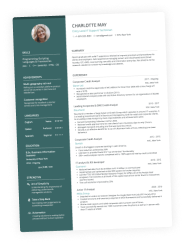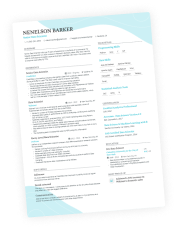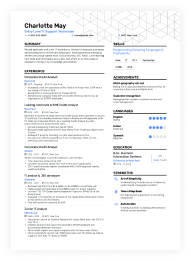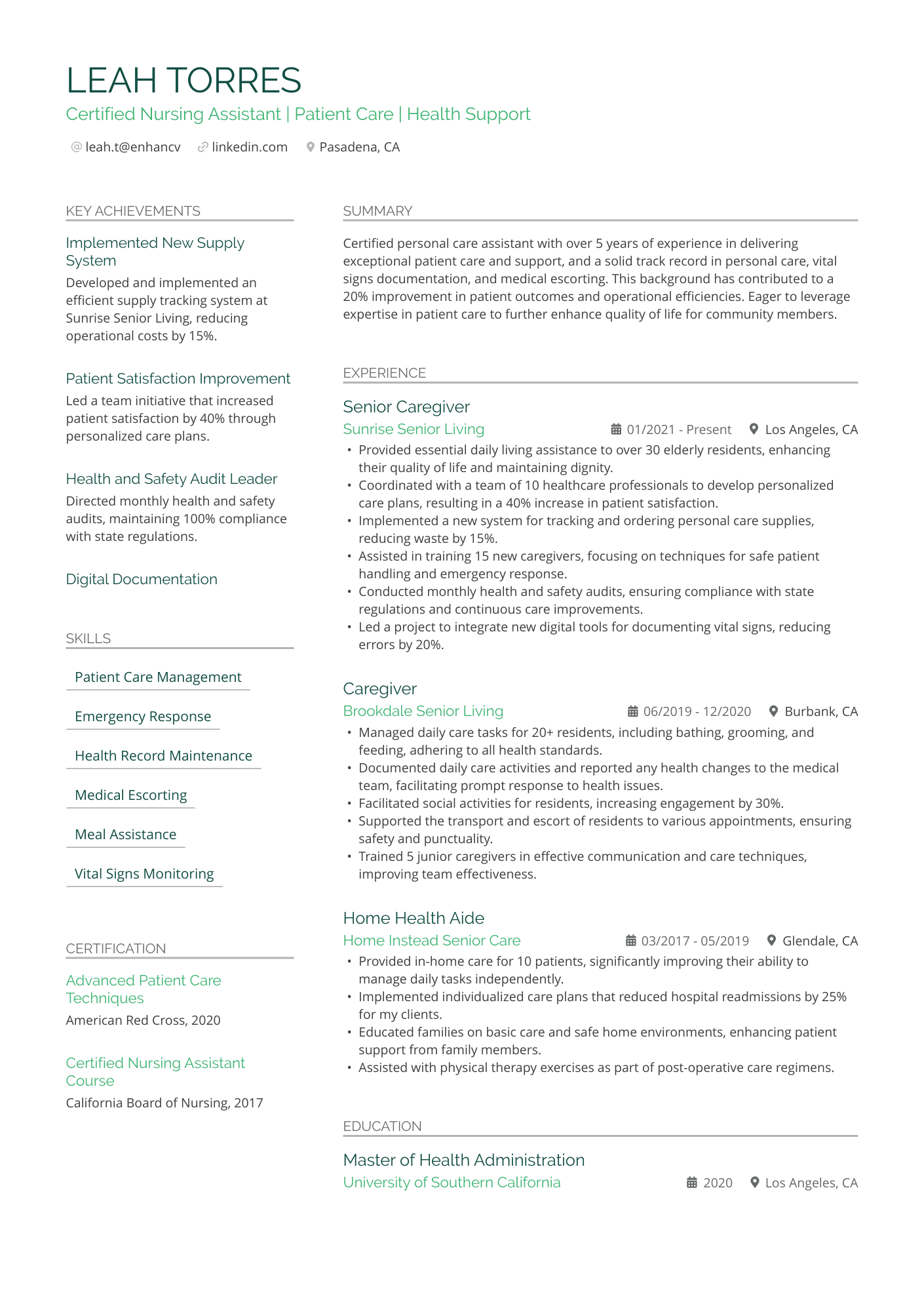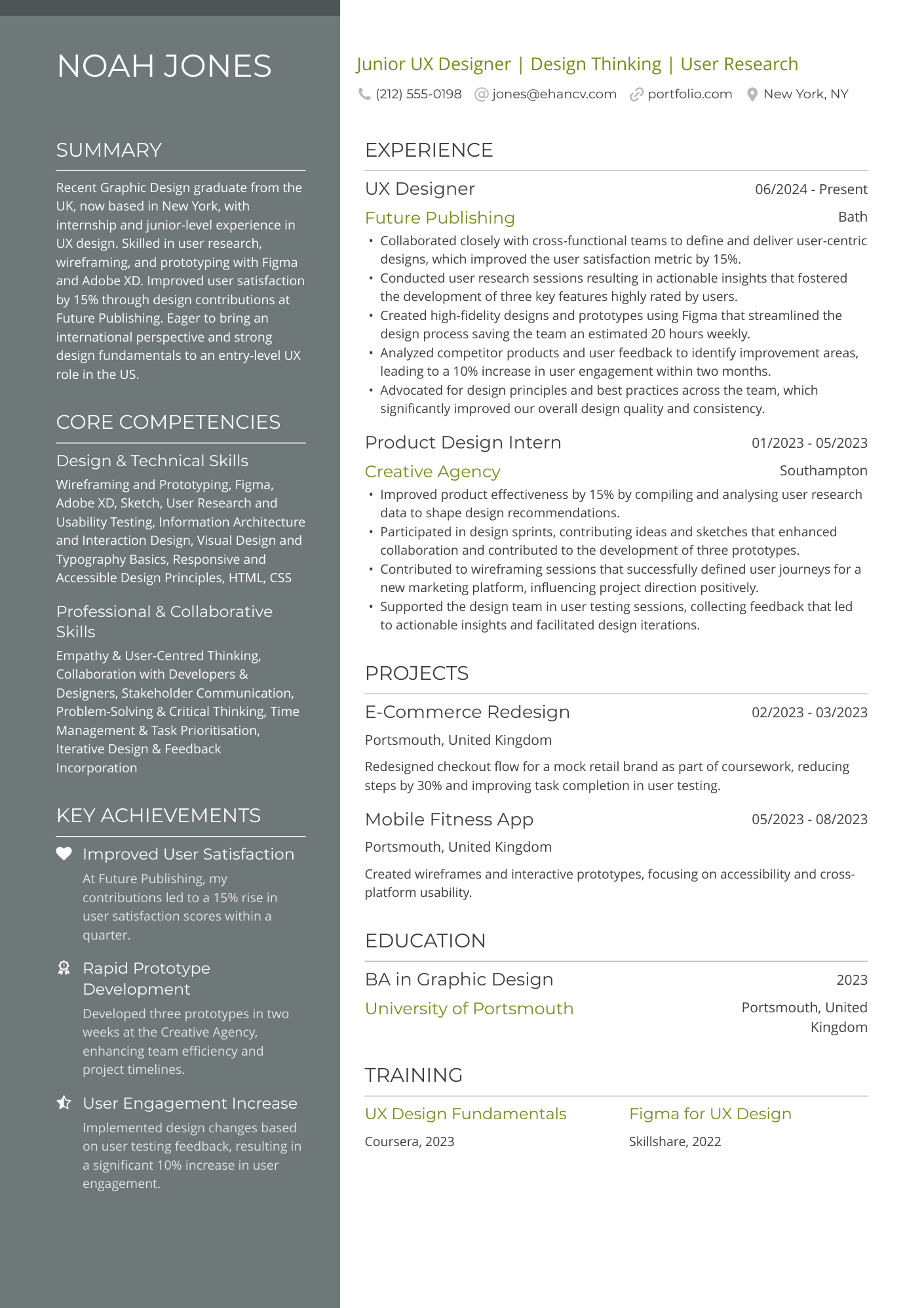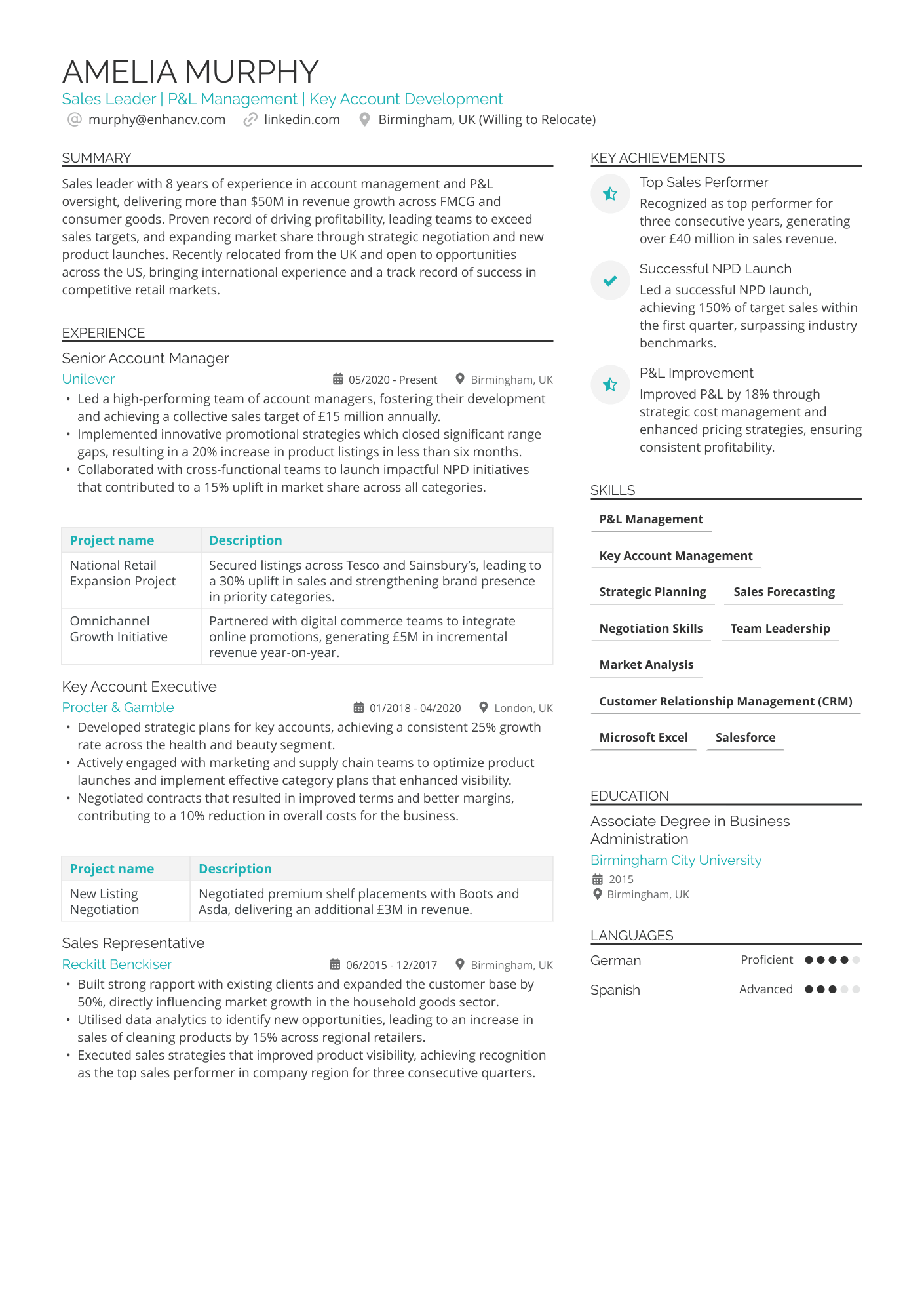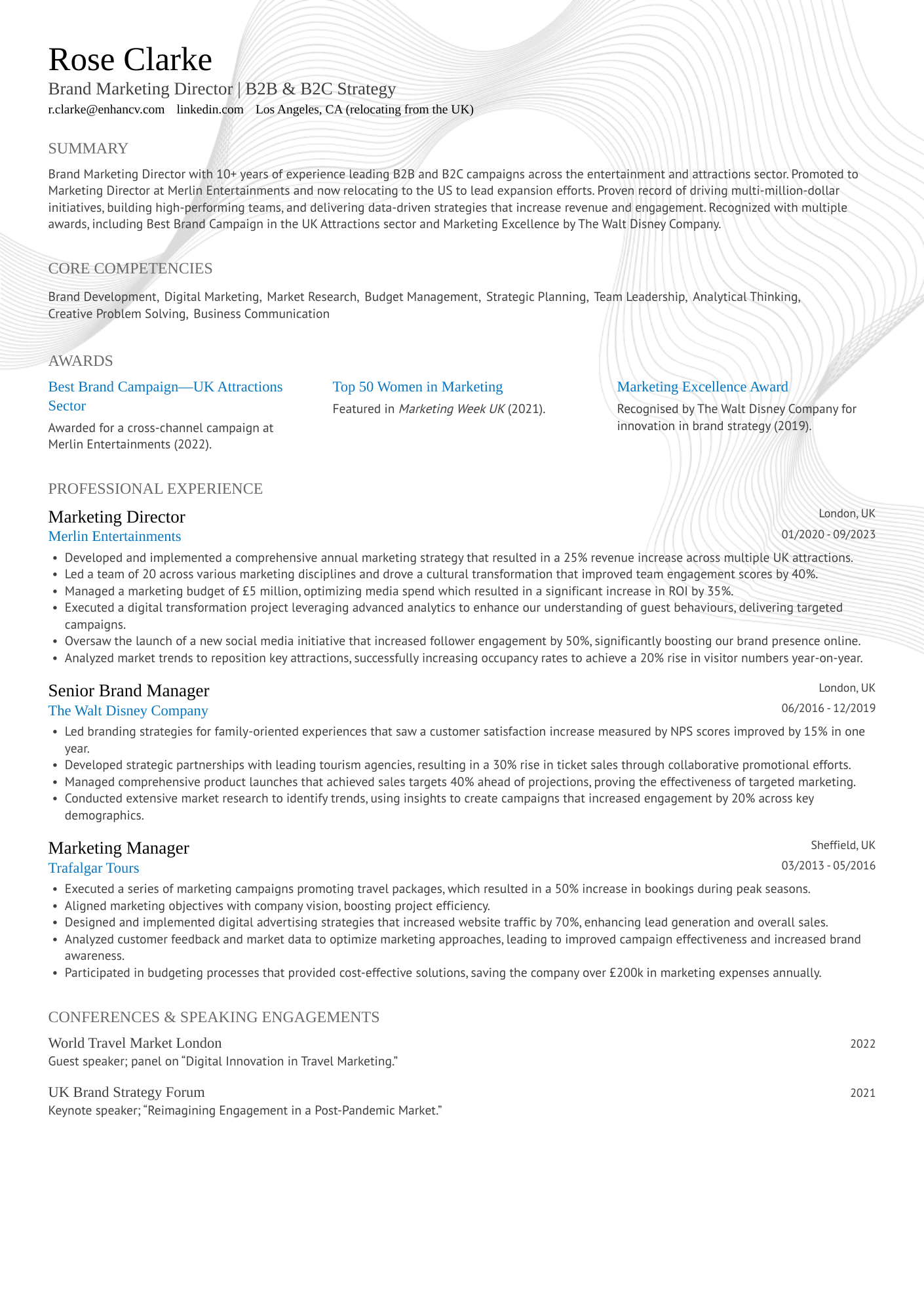Do you dream of a life less ordinary in the United States? If the “land of the free” has been calling your name, working for an American company could be the answer.
There are notable hiring differences between the UK and the US. So, redrafting your CV to create a US resume will dramatically improve your chances of landing an interview.
In this guide, we’ll walk you through each step of the process: from using the correct spellings and concise formatting to aligning with cultural norms, and understanding what exactly US recruiters are looking for.

Key takeaways
- Use a US resume format to grab the attention of American recruiters.
- Use American English, formatting, and terminology to meet their expectations.
- Include a header, summary or objective, work experience, education, and skills.
- Optional sections like certifications, projects, and affiliations can add value.
- Highlight interactions with American clients, vendors, or multinational projects to show familiarity with the US market.
- Leave out personal information and format your resume for applicant tracking systems using keywords from the job description.
Have you already created your US resume? See how it measures up with our CV Checker below:
Is your CV good enough?
Drop your CV here or choose a file. PDF & DOCX only. Max 2MB file size.
Let’s kick things off by dealing with the elephant in the room—why do you need a separate document when applying for a job in the US?
Why should you create an American CV?
In the United States, the standard job application document is called a “resume.” It’s essentially the American word for CV, but a resume is shorter, more concise, and formatted to suit US hiring practices.
In this article, we’ll use the terms US resume and American CV interchangeably to make things clear.
You might think your standard CV will work just fine for a US role. But American recruiters can usually spot a British CV straight away, and it might only leave them a bit confused.
Here’s why:
- It shows a lack of awareness: When you’re applying for a US role, showing that you understand the American hiring market is a must. The fact that you have not sent a US resume tells the recruiter that you’re not clued up to the standards in the country.
- Differences stand out: Small things—like UK spellings and CV formatting—can stand out for all the wrong reasons. A recruiter may reject your application simply because it doesn’t fit the structure they expect.
- It can lead to misunderstandings: The recruiter may think you didn’t realise the role was based in the US, since you haven’t adapted your CV. For that reason, they could decide not to pursue you as a candidate and save themselves some time.
- It may underperform in ATS scans: US applicant tracking systems are built with American resume conventions in mind (e.g. US job titles, GPA instead of degree classifications). A British CV might not tick the right boxes, which means you’ll rank lower in terms of keyword matching.
Next up, we’ll cover the notable differences between a standard CV and an American CV. Taking the time to craft a US resume shows that you’re committed to finding a role in America.
What makes a UK CV different from a US resume
| Aspect | British CV | American CV |
|---|---|---|
| Name | In the UK, we use the term ‘Curriculum Vitae’ or ‘CV’ for short. | In the US, the term ‘resume’ is standard. (However, Americans use CV when referring to academic applications.) |
| Length | CVs are usually up to two pages long, with some CVs being even longer. The space means you can add a detailed work history, education, and skills sections. | Resumes are typically one-page long and, in rare cases, two. The focus is on highlighting the most relevant career feats and qualifications. |
| Purpose | The aim of a CV is to give hiring managers a complete overview of your education and experience. It shows off any rare talents you have while going in-depth when it comes to your academic background. | Resumes are a snapshot of experiences and qualifications, designed to grab the reader’s attention. You can be more selective about what you share on an American CV than a UK CV. |
| Tone | When writing a CV, your tone should be professional and factual. British hiring managers may prefer a more direct and to-the-point approach, without too many flourishes of creativity. | Switch your tone to be more confident and assertive when writing a US resume. It may be a generalisation, but Americans adopt a more forthright approach when speaking about themselves professionally. |
| Sections | CVs typically include the following sections in this order: header, personal statement, work history, detailed education, and skills. There are optional extras, too, such as certifications, languages, and hobbies & interests. | Resumes include a header, summary or objective statement, work experience, education, and skills section. Extras may include things like certifications and licenses, and professional affiliations. |
As you can see, there are plenty of subtle differences between a UK CV and an American CV. Navigating these minor tweaks is the best way to boost your chances of success.

Your resume needs to be in American English
One thing that often trips candidates up is whether to write their resume in British or American English. The answer is to consider the end user—the recruiter.
Since they’re American, you should write your application for them. That means using American spellings and terminology.
Later in this guide, we'll take a look at how to do that.
If you already have a master CV in the bank, now’s the time to revisit it. You can either tailor your application to create a resume for the US, or start from scratch.
Next, we explore how to do that.
How to format your CV for the American job market
The content of your CV and a resume will have a great deal of overlap. However, it’s the way you present it that matters here. You’ll need to remix the document to make sure it suits US hiring standards.
To help you do that, follow this advice:
Keep it to one page in length
Chances are, you’re familiar with the British CV length standard. That means creating CVs that are two (and sometimes more) pages in length. However, CVs in the US tend to be much shorter.
Ideally, your US resume should be kept to one page. While our research shows that two pages are becoming more common for senior professionals, the standard expectation is still a single page. To achieve that, you’ll need to be ruthless with editing and only include sections that add real value to the role you’re targeting.
Make use of white space
Since US resumes are usually expected to fit on a single page, white space plays a much bigger role than on a UK CV. It’s not just about design—it’s about guiding the recruiter’s eye to the right places.
US recruiters skim resumes in seconds, so avoid cramming too much onto the page. Keep margins at around one inch (roughly 2.5 cm, compared with the slightly tighter margins often used on UK CVs) and leave consistent spacing between sections. This breathing room ensures the layout looks clean and helps your most important achievements stand out instantly.
Write clear headings
As we’ve covered above, resume sections don’t tend to have the exact same titles as typical CV sections. When labelling your headings, use the American terms (not the British ones).
For example, use “Objective Statement” or “Summary”, rather than “Personal Statement”. These small details are important and show that you’ve done your research before applying to US roles.
Use bullet points throughout
The best resumes are eye-catching and scannable. If you want to hit both of those marks, using bullet points throughout is the answer. While these are a common feature in UK-specific CVs, they are all the more important when it comes to resumes.
That’s because scannability is everything. You want to share as much value as possible in the least amount of words. You can do that by cutting to the chase and using bullet points instead of paragraphs.
Here’s an example of how a well-formatted US resume would look:
Now that you’ve got the basic formatting down, the next step is to perfect the sections.
What sections to include in an American resume
While the sections of a resume are similar to those of a CV, they are not the same. Following the right structure is a must if you want to win over American recruiters.
Here’s what to include:
Header
At the top of your US resume, add a short header. Include your basic contact information: your name, job title, location, phone number, and a professional email address.
Since you’re looking to relocate, slide that detail in here. You can simply add “Willing to Relocate to the US” (or the specific state) next to your location.
Header
Oliver Bennett
Frontend Developer
London, UK | Willing to Relocate to the US
+44 7700 9001XX | oliver.bennett@email.com
If you have an up-to-date LinkedIn, portfolio page, or professional website, you can hyperlink it in this section, too. However, make sure it’s 100% relevant to the job you’re going for.
Summary or objective
Next up, your summary is a snapshot of your career so far—detailing your biggest wins and achievements. It should be three to five lines long and include your top skills, qualifications, and notable feats that make you right for the job.
You may want to reaffirm your willingness to move for the role in this statement, if you have the space.
Let’s take a look at an example below:
Summary
Results-driven Marketing Specialist with 5+ years of experience developing digital campaigns that boosted brand engagement by 40%. Skilled in SEO, content strategy, and social media management, with a track record of driving growth for both UK and international clients. Certified in Google Analytics and eager to bring expertise to a US-based team.
New to the working world? You can use an objective statement instead. Unlike a summary, which looks at your career history, this statement looks forward and focuses on your career goals. Be clear about how this move to the US fits into your long-term professional plans.
Check out our example of an objective statement here:
Objective
Recent Marketing graduate from the University of Leeds, UK, aiming to join R/GA’s New York office as a Junior Digital Marketing Associate. Eager to apply strong skills in content creation, social media, and data analysis while gaining hands-on experience in a dynamic international environment. Committed to contributing to company growth and developing a long-term career in the US.
When you’ve nailed this initial statement, the next step is moving onto your work history.
Experience or work history
When writing your US resume, pick out relevant positions that align with the role you’re applying for. Since you only have a little space, aim for between three to five roles. This is slightly different from how you would approach a CV.
The question on the recruiter’s mind will be: Do they understand the US market? To prove that you do, include any experience you have with Americans or multinational businesses.
I'd also advise explicitly mentioning or highlighting interactions with any US clients, vendors or tools to signal a global fluency and relevance to the US ecosystem.
For each role in your experience section, include:
- Job title
- Company name
- Date you worked there
- Bullet points covering your accomplishments
Add in metrics, such as numbers and statistics, to back up your claims. These catch recruiters’ eyes and show that you can get solid results.
Take a look at our example to get you started:
Work experience
Marketing Coordinator
BrightWave Digital, London, UK | June 2021 – Present
- Managed social media campaigns for multinational clients, including US-based brands, increasing engagement by 35% in six months.
- Coordinated email marketing campaigns using HubSpot and Salesforce, achieving a 20% higher open rate than industry average.
- Collaborated with US marketing teams to adapt campaigns for North American audiences, improving lead conversion by 15%.
Marketing Assistant
Global Media Group, London, UK | January 2019 – May 2021
- Supported cross-border marketing projects with US vendors, ensuring brand consistency and timely delivery.
- Conducted market research on US consumer trends, providing insights that informed campaign strategies.
- Designed content for newsletters and social media posts, boosting click-through rates by 25%.
The above example uses the STAR method to accurately show the impact the candidate had on the business.
Here’s what it’s about:
- Situation: Start with the situation you found yourself in.
- Task: Talk about the task you needed to complete.
- Action: Share the action you took to get the task done.
- Results: Conclude with the results (and be sure to use metrics here!).
This tried-and-tested method is easy for recruiters to follow. At a glance, they can quickly see the value you bring to a business.

PRO TIP
Each time you submit a new job application, be sure to tailor this section of your resume. Align your examples with the demands of the job at hand so the recruiter can instantly see how your work history connects to their needs. Enhancv’s Tailoring feature makes this process quicker, helping you adapt your experience entries for each role without starting from scratch.
Your work experience is only part of the story. When you’ve completed this section, move onto your education.
Education
When writing a British CV, your education section does a lot of the heavy lifting. However, that’s not always the case for US resumes. You can actually leave your education off completely if it’s not relevant to the role you’re applying for or if it was earned years and years ago.
If you do include it, you can keep the details to a minimum unless it’s directly relevant to the vacancy or you’re applying for an academic role. Trimming back on the information you share can be a huge help, especially when you only have limited space to play with.

Convert your qualifications to US standards
Let’s face it, an American recruiter may not have a clue what an A-Level is. That’s bad news for you as a candidate. Research the equivalent qualifications in the US and use their titles. This approach means that you will better align with the reader’s expectations.
For each qualification, you need to include the subject, the institute (e.g. school or university), the original and converted title, your grades, and the date you achieved the certificate.
Here’s an example of how that may look:
Sample education entries
Bachelor of Science in Marketing (equivalent to US BSc)
University of Manchester, Manchester, UK | First-Class Honours | 2014 – 2017
A-Levels (equivalent to US High School Diploma with Advanced Placement)
Manchester High School, Manchester, UK | A in Economics, B in English, A in Business Studies | 2012 – 2014
GCSEs (equivalent to US High School Diploma foundational courses)
Manchester High School, Manchester, UK | 9 GCSEs including Mathematics (A), English (A), and History (B) | 2007 – 2012
If you’re an entry-level candidate, it can be worth listing your GCSEs and A Levels, even if you already hold a degree. But beyond the entry level, American recruiters rarely pay much attention to high school diplomas, so you don’t need to emphasise them.
Next up, let’s tackle the skills section.
Skills
The skills section you use for a US resume should be similar to the one on your standard CV. Focus on hard skills, including technical abilities and software proficiency first and foremost. You can also include some soft and transferable skills) if they align with the role.

Check the job description for key skills!
The job description or core criteria will likely list “must have” and “nice to have” skills. Look at it first and see which you already have. Make sure you include them on your US resume (as long as you can prove them).
Use the same words from the job description, instead of synonyms. This approach will help you parse the Applicant Tracking System (ATS) if the recruiter is using one.
You can separate your skills into hard and soft lists. For hard skills, it’s often wise to give a basic proficiency level. For soft skills, on the other hand, you can add some context.
Check out an example below:
Skills
- SEO & SEM – Advanced
- Google Analytics – Intermediate
- HubSpot & Salesforce – Advanced
- Content Creation & Social Media Management – Advanced
- Microsoft Office & Google Workspace – Advanced
Core competencies
- Cross-cultural Communication – Collaborated with US-based teams to adapt campaigns for North American audiences
- Project Management – Coordinated multiple marketing campaigns, meeting deadlines and budget requirements
- Problem-Solving – Resolved client challenges by analyzing data and recommending actionable solutions
The above resume sections are essential. But what if you have extra space on the page? You can include some optional sections so long as they add value to your application.
Certifications and Licences (if applicable)
Do you have professional certificates or licences for your field? Bonus points if these come from American accreditors or providers!
Creating a dedicated licence and certificate section is the way to showcase them. Lay this out in the same style as your education section.
Take a look at our example to see how it would look:
Licenses & Certificates
Google Analytics Individual Qualification (GAIQ) – Google | 2022
HubSpot Content Marketing Certification – HubSpot Academy | 2021
Certified Digital Marketing Professional (CDMP) – Digital Marketing Institute | 2020
Of course, if any of these have expired or need updating, you should leave them out.
Publications and presentations (for academic or high-level jobs)
Going for an academic or senior role? If you’ve hosted presentations, authored research papers, or been published in a journal, now’s the time to shout about it. Adding a section dedicated to these feats shows your expertise in the field.
Let’s take a look at how you can lay it out:
Publications
- “Optimizing Content for North American Markets,” Marketing Leaders Conference, 2023
- “Adapting Social Media Campaigns for Global Audiences,” MADE Talks, 2022
Should the talk or the paper be available online, you may want to add a hyperlink to it. That way, the recruiter can quickly verify it without having to reach out to you.
Professional affiliations (if applicable)
Professional affiliations—especially those that cross geographic borders—are a quick way to show you’re a leader in your field. These may include memberships to relevant professional organisations or associations. Highlight them in their own resume section.
Let’s take a look at how this optional section looks:
Professional affiliations
- Member, American Marketing Association (AMA) | 2023 – Present
- Member, Chartered Institute of Marketing (CIM), UK | 2020 – Present
In most cases, you don't need to bullet point your duties or role in these associations. However, if you have specific leadership duties, you can detail them here.
US resume examples by your career stage
Now that you know what to include on your resume, let’s take a look at that in practice. We’ve put together some resume examples based on each career stage.
Graduate or entry-level
If you’re new to the working world, but want to move to the US, tailor your resume accordingly. Focus on the skills you bring to the table and how they will benefit the employer.
Here’s a resume example:
Mid-level professional
If you’re in the middle of your career, you can draw upon your experiences so far. Make it clear that moving to America is a natural progression and show how it fits with your long-term goals.
Take a peek at our example here:
Senior-level professional
Once you’ve reached the highest heights of your career, you can use your achievements as leverage. Spotlight the results you’ve gained and show recruiters what you can do for them.
The example below subtly weaves in promotion and career successes as the candidate’s key assets. Note that at this level, education takes a back seat to professional accomplishments
Whatever your career stage, it’s important to make your resume attractive to American recruiters. You can do that by speaking their language—literally. With Enhancv’s professionally designed resume templates, you can create equally impressive resumes and CVs that highlight your value clearly and effectively.
Cultural differences: talk the recruiter’s language
By this point, you should be feeling confident about adapting your CV to be a US resume. However, there are a handful of extra things you need to know.
Here’s a breakdown:
Use Americanisms and spellings
It’s not simply about switching your esses to zeds. Instead, you need to make sure you use proper American terminology when writing your application. Don’t just rely on what you think you know. Either look things up or use an American spellcheck to make sure you get it right.
Using Enhancv’s AI Resume Builder can help you get it right. You can turn to our resume examples for inspiration any time you need extra help Americanising your content.
In my opinion, using US spellings shouldn't be a compromise. This small detail can reflect a candidate's cultural awareness and the efforts taken to tailor the resume. A simple spell check on Google Docs or Grammarly can help catch the spelling mistakes.
Adopt a confident and assertive tone
It’s a cliche for a reason. Brits are typically more demure and understated when it comes to self-promotion. But when it comes to how to write a CV in American style, confidence is key.
Adopt a more assertive tone, and don’t be afraid to toot your own horn. Putting your best achievements front and centre is the way to go. Lead with powerful action verbs to show that you’re the one in the driving seat.
Focus on your achievements
American recruiters are on the hunt for candidates who can get real results. Including metrics in your resume shows them you’re the person for the job.
I've known US employers to be mostly result-oriented and they tend to scan for impact metrics. My best tip is to quantify resumes and back work experience with numbers, like revenue growth and cost savings.
Ditch the personal information
When applying for jobs in America, it’s important to follow local privacy laws and standards.
This means you should not include:
- A photo of yourself
- Marital status
- Date of birth
These details can reveal personal characteristics that have no bearing on your ability to do the job. US resumes should simply include your professional skills and qualifications. That way recruiters only hire candidates based on merit.

Make sure your resume is ATS-friendly!
Around 70% of large organisations and 75% of recruiters now use ATS. While this software won’t automatically reject your resume, you still need to keep it in mind.
To ensure your application can be read by the software, do the following:
- Use the standard headings (which we covered earlier).
- Include keywords and phrases from the job advert.
- Avoid including any tables, graphs, and imagery.
- Adopt a solid format—use one of our simple US templates.

Common mistakes to avoid for US CVs
You don’t want to fall at the final hurdle. Here are some pitfalls to avoid on your American CV:
- Putting all of your experience on your resume: You should be selective about the experience you share on your resume. Pick out your highlights and roles that align with the vacancy to save space.
- Underplaying your achievements: Emphasise the achievements you have and be clear about how they benefited former employers.
- Letting UK spellings slip through: Before sending your resume, go through it with a fine-tooth comb and make sure you Americanise all the spellings.
- Listing vague bullet points: Each point you include needs to add something new to your resume. If it doesn’t hold any value, edit it out for the sake of space.
- Including a headshot: It’s a common misconception that US resumes include headshots. Leave out any pictures or identifying details like your date of birth.
- Adding references: References don’t typically need to be on your resume. Much like British recruiters, Americans are likely to see this as an outdated practice and, frankly, unnecessary.
- Failing to localise qualifications: Using British-style qualifications is one of the fastest ways to alienate US recruiters. Always localise them to ensure clarity.
Frequently asked questions
Looking for some more answers? We’ve outlined some of the frequently asked questions below:
Can I apply for US jobs while still living in the UK?
Yes, you can. Just make sure you’re clear about your willingness to move to the States. You can add this to your CV, mention it in your cover letter, and talk about it at an interview.
Do I need a work visa to apply for jobs in the US?
You need either a visa or sponsorship to work in the US. However, you can start applying for jobs before you have this. Make sure you're upfront with recruiters about your position.
If you want to relocate to the US for work, you’ll need one of the following things:
Understanding the immigration process is the first step, so you can ensure you have dealt with all of the legal red tape. Check the government’s information page for more details.
Can employers sponsor my visa if I’m applying from the UK?
Yes, some American employers can sponsor work visas for British candidates. However, it depends on the demand for the role in question.
How do you find jobs in America when you’re British?
When you’re on the hunt for a job in America, you need to be strategic. Looking in the same old places is unlikely to get you the results you want. Here are some options to explore:
- Job boards: Opt for US-centric boards, such as Monster, ZipRecruiter, and Indeed.
- LinkedIn: You can also check LinkedIn and use the country filter when searching.
- Government sites: Look at sites like CareerOneStop.org or USAJobs.gov too.
- Company websites: Search career pages for American companies.
- Specific immigration boards: Try niche job boards, such as MyVisaJobs.com.

Apply for jobs before they’re advertised!
Looking to work for a specific company? Consider sending a cold email to the hiring manager with your US resume and your situation.
While you won’t always get a reply, if your message reaches them at the right time, you might get your foot in the door.
Cast the net far and wide when it comes to your job search. The role you’ve been looking for may only be advertised on the company website or in a post on LinkedIn.
How can I highlight my experience with US businesses?
If you haven’t directly worked for an American business before, consider the times you’ve worked with them. For example, your employer may work with American clients. Address this in your work experience section and draw upon any times you’ve dealt with a US company.
Conclusion
If you want to impress American recruiters, you’ll need to present them with a US resume. Use the right format, keep it to one page, and adapt your language to suit the reader. Throw in choice metrics to wow the recruiter, and you’re off to a great start. Ready to get moving? Use our CV Builder tool to create yours now.

